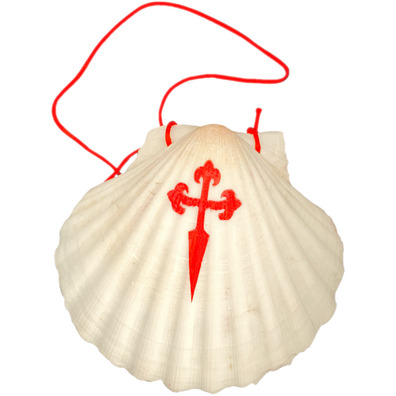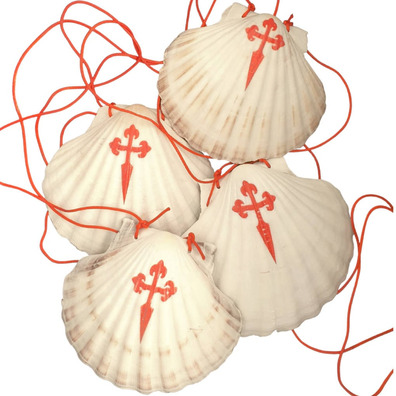Pilgrim Shell | Scallop Camino de Santiago
1,50€
Taxes includedCatholic product in stock. Products ready to be shipped. You can check the approximate delivery time during the purchase process.
Pilgrim Shell | Scallop Camino de Santiago
- Natural scallop shell.
- Typical pilgrim shell of the Camino de Santiago de Compostela.
- Decorated with the classic Cross of Santiago in red.
- Santiago shell with red cord to tie to the backpack or hang around the neck.
- Each of the shells is unique in terms of shape, color and size.
- Approximate measurements:
- 11cm Wide.
- 10cm long.
Pilgrim shells, symbol of the Camino de Santiago
The scallop of the Camino de Santiago, also called Venera or Concha de Santiago , is one of the most important symbols or distinctives that identify a pilgrim. More and more walkers on the Camino de Santiago are wearing a scallop shell and the mythical pilgrim's staff. Other emblems of the pilgrim on the Camino de Santiago are the wide-brimmed hat, the cape with a cape, the gourd to store water or wine, and the backpack.
The Pilgrim's shell has been included by Benedict XVI in the papal coat of arms, so its importance as a religious symbol is even greater.
Pilgrim shells, origin of the symbol of the Camino de Santiago
There is a great variety of opinions about the origin of the integration of the scallop shell as a symbol of the pilgrims of the Camino de Santiago .
The scallop shell came to be called Concha de Santiago or Conchas del Peregrino because when the pilgrims finished the Camino de Santiago and arrived at Compostela, they were given two things. On the one hand, pilgrims on the Camino are given a parchment that officially confirmed them as pilgrims on the Camino de Santiago . On the other hand, the scallop shell was placed on their hat and cape, which, "among other things", demonstrated their stay in Santiago so that, on returning to their home towns, there would be no doubt about their "achievement and personal merits.
There was an important market in the city of Santiago around the commercialization of scallop shells. The sale of scallop shells outside Compostela was scrupulously prohibited under threat of excommunication from the Catholic Church. In the different establishments of Santiago, all kinds of pilgrim shells were sold: authentic pilgrim shells brought from the beaches of Galicia, small pilgrim shells in different materials that were sold as amulets and souvenirs for relatives and friends of the pilgrims. and visitors to the city, scallop shells in pieces of wood or metal as souvenirs, etc...
Shell of Santiago, religious symbol of the Camino
From a religious point of view, the scallop shells , arranged like fingers, are said to signify the good deeds in which one must persevere in life until the goal is reached. Therefore, as the pilgrim carries the shell, he must continue advancing on the Camino de Santiago to reach the ultimate goal, which is to see the Apostle Santiago. In addition, just as the pilgrim carries the scallop shell around his neck, any human being must carry the yoke of the Lord and submit to his Commandments.
Shell of the Camino de Santiago, other meanings
The religious meaning of the shell of the Camino de Santiago is the most important symbolism in our days. The great fame that the Camino de Santiago has achieved and the thousands of pilgrims who visit the Apostle every year are witness to this fact.
In the past, other meanings have been attributed to the shells of the Camino de Santiago. For example, due to the shape of the scallop shells, the Concha de Santiago resembles the webbed foot of a goose, the shell of Santiago was considered a symbol of initiation recognition. This award for achieving a goal would be related to the pilgrimage to Compostela .
Finally there is another possible version of its meaning. It would be that the scallop shell, as a symbol of Venus, means the rebirth of a person, his resurrection; that is, the "death" or overcoming of the "ego" (selfishness and self-centeredness) to give way to the "authentic self" (simple and humble). The shell of Santiago , the pilgrimage through the Camino de Santiago, is also closely related to this. The one known as the inner Path, the personal journey, the encounter with God and the overcoming of the chains that bind us to material goods.






